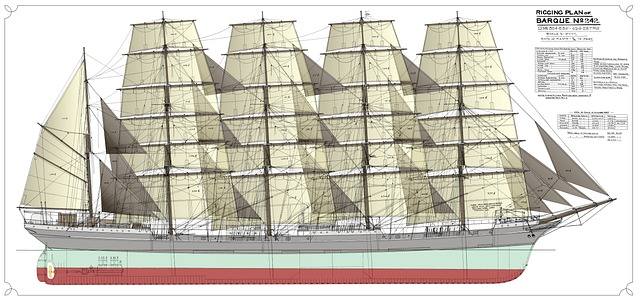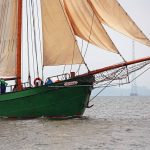As ship experts, we understand that tall ships have an undeniable charm and elegance that simply cannot be matched by modern vessels. These majestic beauties harken back to a time when the world was still being explored and mapped, and adventure was still alive and well.
If you’re a sailing enthusiast, or just someone who appreciates the beauty and history of tall ships, it’s important to understand the different parts – or “anatomy” – of these remarkable vessels.
In this article, we’ll take an in-depth look at each part of a tall ship, providing you with a comprehensive guide that will have you speaking the language of sailors in no time.
Hull
The hull is the main body of the ship, and is responsible for keeping everything afloat. It’s important to understand that the hull is not just one solid piece, but is actually composed of many different parts, each with its own specific function.
For example, the keel is the spine of the ship, running from bow to stern and providing stability and direction. The planking is the outer layer of the hull, and is made up of a series of boards that have been carefully fitted together to create a watertight seal.
The shape of the hull is also critical, as it affects the ship’s speed, stability, and maneuverability. A tall ship’s hull is usually long and narrow to reduce drag and increase speed.
Masts and Sails
One of the most distinctive features of a tall ship is its massive masts, which can reach heights of up to 100 feet or more. These masts are constructed from sturdy wood or metal, and serve as the backbone that provides support for the sails.
A tall ship can have several masts, ranging from one to seven. The tallest mast is called the mainmast, and it’s usually located in the center of the ship.
The sails are made of canvas or other lightweight materials and are attached to the masts and rigging. The size and shape of the sails can vary depending on the ship’s design, and the crew can adjust them to catch the wind and propel the ship forward.
The sails themselves are also impressively large, and can be adjusted to catch the wind and propel the ship forward. Understanding the different types of sails, such as jibs, mainsails, and topsails, is crucial for any sailor looking to master the art of tall ship sailing.
Rigging
In addition to masts and sails, tall ships are also equipped with a complex system of rigging that helps to control the movement of the ship. The rigging includes ropes, cables, and chains that are used to hoist sails, adjust the angle of the masts, and provide stability in rough weather.
- The shrouds are thick ropes that run from the mast to the sides of the ship and help support the mast.
- The stays are wires that run from the top of the mast to the front and back of the ship and help keep the mast upright.
- The halyards are ropes that raise and lower the sails.
A skilled sailor must be adept at working with and manipulating the rigging, as it is a critical component of keeping the ship under control in all conditions.
Deck
The deck is the top level of the ship, and serves as the main workspace for the crew. On a tall ship, the deck is typically divided into different areas depending on the function of each area.
For example, the bow is the front part of the deck where the anchor is stored, while the stern is the back part where the steering wheel and rudder are located.
Other important areas include the forecastle, which is where the crew’s living quarters are located, and the poop deck, which provides a higher vantage point for navigation and lookout.
The lower deck is where the crew sleeps and eats. The quarterdeck is the area at the back of the ship where the captain and officers stand.
Anchors
Anchors are used to keeping the ship in place when it’s not moving. A tall ship can have several anchors, depending on its size and the conditions it will face. The anchor is attached to a chain or rope that’s wound around a winch.
When the anchor is dropped, the chain or rope unwinds, and the anchor sinks to the bottom of the ocean floor. To lift the anchor, the crew uses the winch to wind the chain or rope it back up.
Crow’s Nest
The crow’s nest is a small platform located at the top of the mast. The crew member stationed in the crow’s nest, called the lookout, is responsible for watching for other ships, land, or other hazards.
The lookout has a panoramic view of the surrounding area, and their job is critical to the safety of the ship.
The last word
In conclusion, understanding the different parts of a tall ship is absolutely essential for anyone with an interest in sailing or maritime history.
From the hull to the deck, each part plays a critical role in ensuring that the ship is seaworthy, and that her crew can navigate her safely to their chosen destination.
Whether you’re a seasoned sailor, or just someone who appreciates the beauty and majesty of tall ships, we hope that this guide has given you a deeper appreciation for these remarkable vessels.
So the next time you find yourself aboard a tall ship, take a moment to look around and marvel at the truly breathtaking engineering that has gone into its creation.


![How to Keep Your Tall Ship Clean and Maintained [Video] How to Keep Your Tall Ship Clean and Maintained [Video]](https://www.tallshipssunderland.com/wp-content/uploads/2023/03/tall-ship-cleaning-maintenance-150x150.jpg)
![How to Maintain and Repair Sails on a Tall Ship [Video] How to Maintain and Repair Sails on a Tall Ship [Video]](https://www.tallshipssunderland.com/wp-content/uploads/2023/03/tall-ship-sail-repair-150x150.jpg)

![The Best Tall Ship Models for Collectors [Ultimate Guide] The Best Tall Ship Models for Collectors [Ultimate Guide]](https://www.tallshipssunderland.com/wp-content/uploads/2023/03/tall-ship-models-150x150.jpg)
